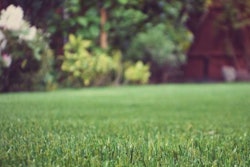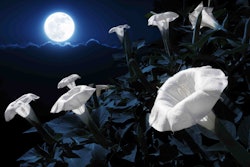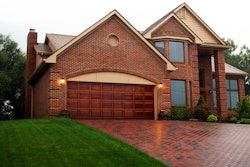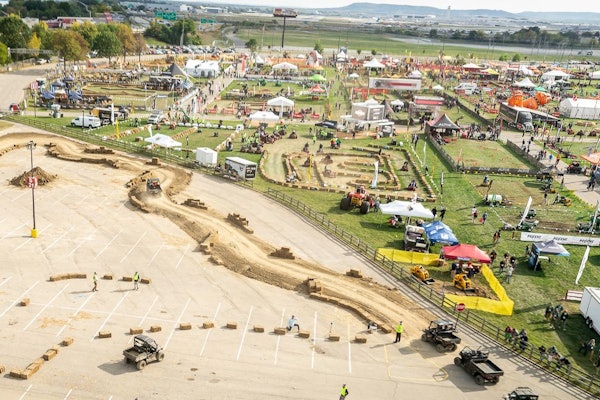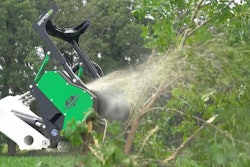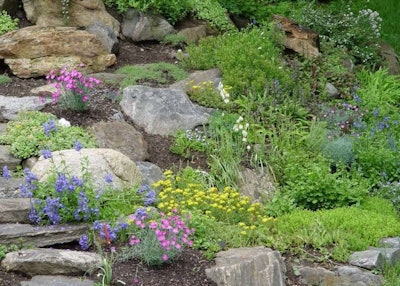 The uses of rocks in the landscape are numerous and can fit various landscaping styles.
The uses of rocks in the landscape are numerous and can fit various landscaping styles.Photo: Jan Johnsen
Stone has always had a sense of permanence to it and even though over time it can be weathered, cracked or made silky smooth by the elements it is not nearly as fussy as some of the plants landscapers have to nurture.
These silent sentinels can be quite versatile when it comes to landscape design and can be placed in a number of ways that are both practical and powerful. Here are five ways that stone can be utilized in your future designs.
Stone steps
One of the more popular usages for stones in the landscape is steps. They’re durable, weatherproof and, depending on the style used, can appear like they have been there since the dawn of time.
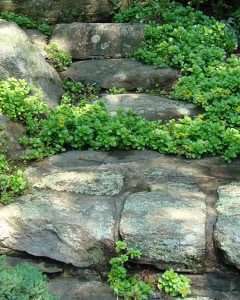 Boulder steps can blend in further with plants growing in the crevices.
Boulder steps can blend in further with plants growing in the crevices.Photo: Jan Johnsen
Rough-hewn boulder steps are one option that can blend naturally with the space. Large, flat natural rocks stacked on one another that are each unique in their own way can serve well as a secondary access point in a woodland area or an already present rock slope. It is important to note that these steps are not ideal for an entryway or a space that has heavy foot traffic.
A close cousin to the bolder steps are the stone slabs, which are more uniform and easier to climb. These can be manufactured from sandstone, limestone, granite and more.
There is also the option of choosing two different stone materials to make up the tread, the horizontal portion of the step, and the riser, the vertical portion of the step. This style is formal and works well for front entries or high traffic areas.
The tread can be made from bluestone, marble, sandstone or other stone materials, but should be without cracks and be relatively smooth. The riser must be set on a firm foundation otherwise it can run the risk of being displaced by frost heave.
Stone walls
Another popular purpose for stones are walls, but there are a lot of different design options and uses that these walls can have. Some can frame a garden or hold back slopes; others provide shelter from cold winds or define a property line.
Masonry is an art and there are many options when it comes to the type of stone used, the construction method and the intended appearance. There are two general methods of constructing a stone wall. Dry stone consists of stacking stones carefully together without an adhesive, and the other method is using mortar.
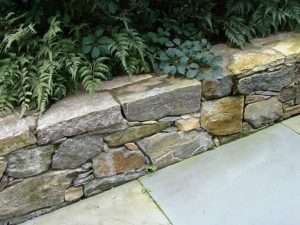 This stone wall features recessed joints but looks like a dry stone wall.
This stone wall features recessed joints but looks like a dry stone wall.Photo: Jan Johnsen
Dry stone walls harken back to a simpler time and are surprisingly durable despite their lack of adhesive. The best stones to use for this style of construction are angular or flat, as they fit together better than rounded stones. Also use larger stones, as tie-through stones that go all the way through the wall help bind it together. When stacking, avoid continuous horizontal or vertical joints by overlapping stones. Uninterrupted seams will weaken the wall. Once the wall is complete, fill in the cracks with slivers of rock known as chinks. They will help stabilize the stone wall further.
A mortared stone wall is useful for retaining purposes, allows for the usage of round or angular stones and is fairly maintenance free. The crucial part of constructing a mortared wall is creating a stable footing that will prevent the stones from shifting. There are many colors of mortar to choose from and they can affect how the stone appears beside it.
Recessed mortar walls take the best of both styles by appearing to be a dry stone construction, but it is actually mortared. The mortar is a 1/2 inch back from the face of the stone. Using mortar with a dark grey pigment can help visually.
Stone seating
Stone benches can be as simple as a single stone slab resting on two other solid square stones, or as complex as a curved bluestone bench resting upon fieldstone piers.
If your client wants the simple three stone construction, make sure the two support stones are no more that 3 feet apart and are wide enough to support the width of the seating slab. The slab should be fairly smooth on both the top and underside so that it is pleasant to sit on and it can rest flush on support stones.
Like all seating arrangements outdoors, be sure to place this stone bench somewhere where there is a feeling of security by placing a hedge or some other solid structure behind it and a beautiful view in front of it.
Dry streams
A very practical use of stone is the creation of a dry stream bed to solve drainage issues. It is used to slow and collect rainwater. They can be placed at the bottom of a slope or up a small rise to catch stormwater before it flows downhill.
 Photo: Jill Odom/Total Landscape Care
Photo: Jill Odom/Total Landscape CareEven when rainwater isn’t flowing through the dry streams, the rocks can give the appearance of peaceful flowing as your eyes naturally travel up or downstream. They can suit a variety of landscape styles, both rural and urban.
To create a dry stream, consider how much rainwater you need to channel before you decide the depth and width the stream bed needs to be. Also to maintain authenticity, allow the shape to meander some. The landscape will dictate most of the direction but keep serpentine paths in your mind.
“But the common element in all of them is that they are filled with an 8-12-inch base layer of coarse gravel, wrapped in filter fabric,” writes Jan Johnsen in her book, The Spirit of Stone. “Atop the gravel, I place a thin layer of decorative rounded river stone to create a more finished look.”
Focal points
In a landscape design, you don’t want the viewer to glance over the whole as one blur of green. You can get them to pause and study the space more closely with the use of focal points. This can also add emphasis to a particular portion of the landscape.
Stones can take on this dramatic role with ease, but there is a little bit more to it than simply finding a boulder and plopping it in the front yard. Take into consideration its size, shape, color, lighting and placement.
By placing a light-colored stone against a dark backdrop of evergreens it is more likely to stand out, just as how placing it at eye-height or elevating it can make it more noticeable. If a stone statue of a lion is an intended focal point, don’t bury in the shade among the ferns where it can go overlooked but rather place it in an optimal viewpoint.
For more advice and options when using stones in landscape architecture, check out Jan Johnsen’s book, The Spirit of Stone, which can be found here.

